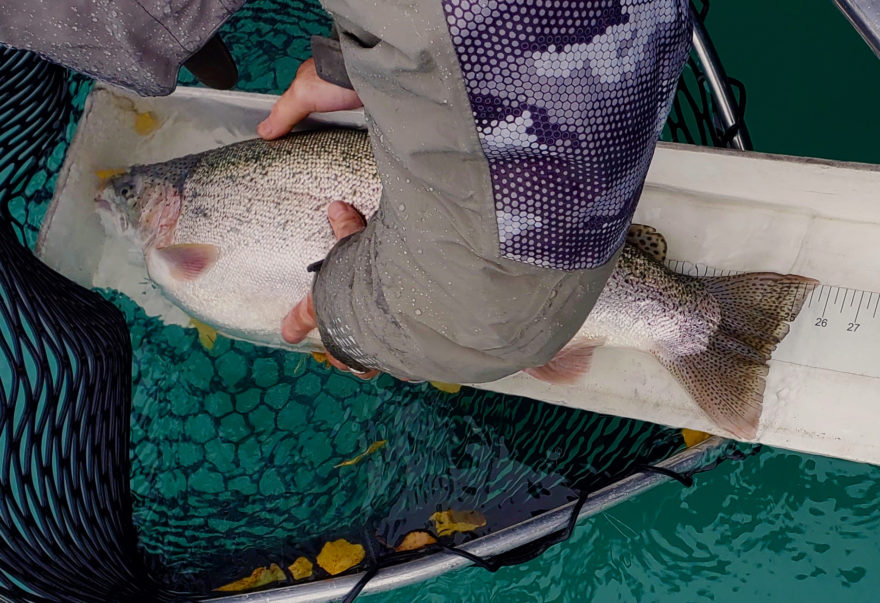
15 Oct September Fishing Report
This September was one for the ages! The Kenai received a record run of pink salmon creating over 40 miles of spawn beds and more food than a trout can dream of. 10lb rainbows were an everyday occurrence, however, the fishing was quite technical. For those of you who witnessed this fall fishery, it is one you will not easily forget.
week 1
The first week of September greeted us with average CFS and consistent water temps setting the stage for greatness. Each day more spawn beds began turning on, and as a result started to consistently hold higher concentrations of bows. Our days focused on maximizing key bites times on the most productive beds, hunting around for more beds becoming active, and finding pockets of big bows. With ample spawn starting from Super Hole all the way to The Pilars, big bows did not have to travel far to find food nor did they have to congregate in high populations with the exceptions of a few zones. The slow trickle of migratory bows up river would be an issue for the rest of September.


week 2
Enter the full glut. A “glut” is a term and phenomenon that we see almost every fall to some degree. It refers to a large amount of food available for trout making the bite very inconsistent. With so many eggs floating down river Kenai bows’ literally do not have to move to feed. They can hone in on egg patterns that do not have hooks attached and if they feel the slightest bit of angling pressure can turn off as they are constantly getting hit in the face by drifting eggs.

With the refuge below Skilak Lake fully glutted, and the Lower River full glutted not a ton of fishing real estate was available. Literally about 4 zones held consistent fishing, there were a few sneaky spots, but were not reliable. This is where the technical aspect came into play. On a normal pink year we see the obvious places holding fish, and all the anglers power lapping it to death, however, there are also plenty of small pockets that hold big fish and typically these are migratory bows. Unfortunately this fall did not have many of those pockets due to the immense glut in the Lower River keeping the bows down there happy with no reason in the foreseeable future to move.

The end result was having to play a daily chess match with the “herd” that hammered on a spot and then all moved together to the next hole.

week 3
Week three was a continuation of week two but with a sneaky bite in the refuge offering reprieve from the chess match below 3rd Hole. Bows continued to pack on pounds and remain hot and cold due to fishing pressure. Fortunately a few more spawn beds began consistently holding good fish, and took the herd most of the week to figure out allowing us to hide in plain sight.

The bite in the refuge was all-time with no-one around to share it with. 10lb rainbow trout were played with daily. The bite was epic, however did not last long maybe a 1/2 hour to an hour. The area holding fish was small forcing us to explore other water, where we did find some other pockets of fish, but was also visited by a few guides looking to escape the gong show down river. Fortunately our little pig pen went undiscovered for almost 10 days before the weekend anglers found it and shut it down going into week 4.

week 4
Week four turned into a Kenai version of the movie, “Ground Hog Day.” Each day was filled with big bows in the same spots mostly during the same time of day. We were still dodging the herd and could not figure out why they all fished together all day long, every day. More of the refuge started fishing, but the spots were quite specific and needed to be left alone for a minute before attempting to hook a good fish. The herd quickly found these new spots to graze in, fortunately this new real estate split the herd into two groups creating a new game, kind of like adding the Seafarers expansion to Catan. As week four blended into early October the writing was on the wall. A massive rain event began soaking the Seward area causing much runoff into the Upper River, which found its way to the Middle. We tested Gore Tex pretty often during late September, and the rain fired up the Killey River, which constantly blew out the fishable water below 3rd Hole. A cleansing was eminent as the CFS went from 7000 in late September to over 18,000 cresting during the end of the first week of October. The amazing fall bite would be put on pause until mid-October when water levels significantly dropped.


We give September 2020 a 5 star rating. Big, fat bows daily, solid weather, and much entertainment watching the herd. The technical aspect of this fall greatly honed in our skillset on trout behavior and timing bites. Constantly moving was and is what we do, but this year our moves needed to be highly calculated for success, and we were very stoked with the outcome.




